If you like mottled and striped patterns of green and white on plant leaves, you may be interested in plants with variegation that is stable and will never revert.
Plants with stable variegation have the same variegated pattern on all the leaves of the entire plant. They can be naturally variegated with variegation encoded in the plant’s DNA. They can also be cultivars with chimeral variegation, where cell mutation happens at the shoot tips producing new cells without chlorophyll.
In the previous article, we have explained the various causes of variegation.
In this article, we will help you find plants with stable variegation using 7 examples. We will also show you an effective way to identify whether a plant has stable variegation by looking at its botanical name.
Let’s get started.
Natural varieties with stable variegation
Plants that are naturally variegated either have variegation encoded in their DNA (pattern-gene variegation) or the variegated pattern appears due to the reflection of light on the leaves (blister variegation). The variegation of both types of plants can be transferred to their offspring via their seeds.
1. Mother-in-law’s tongue
Mother-in-law’s tongue or Snake plant (Dracaena trifasciata, formerly Sansevieria trifasciata) is a popular evergreen houseplant that can grow up to 8 feet from the ground.
All its varieties are naturally variegated with alternating stripes of different shades of green, resulting from different amounts of the green-pigmented chlorophyll in the leaves.
Mother-in-law’s tongue has pattern-gene variegation, which is in the plant’s DNA. As such, the variegation is permanent or stable and will pass onto its offsprings via propagating its cuttings.
Propagation can be made by division, by dividing the rhizome into individual plants and planting them in different pots.
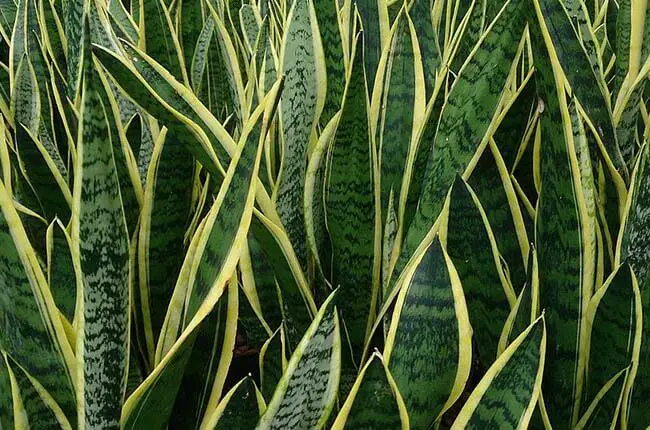
Mokkie, CC BY-SA 3.0, via Wikimedia Commons
2. Rattlesnake plant
The Rattlesnake plant (Goeppertia insignis) is an attractive houseplant that can grow up to 20 to 30 inches (60 to 75 cm) tall.
It has pale green leaves with patches of dark green due to varying amounts of the green pigment chlorophyll on the leaves. Its undersides are purple in color due to anthocyanin which is reddish to purple in color.
The Rattlesnake plant has pattern-gene variegation which is stable as the variegation is encoded in the plant’s genetics. New leaves will produce a similar pattern.
The purple color on the undersides may fade a little when there is insufficient light. But the purple color will intensify under strong lighting because of the release of anthocyanin as part of the plant’s defense mechanism in response to environmental stress such as strong light.
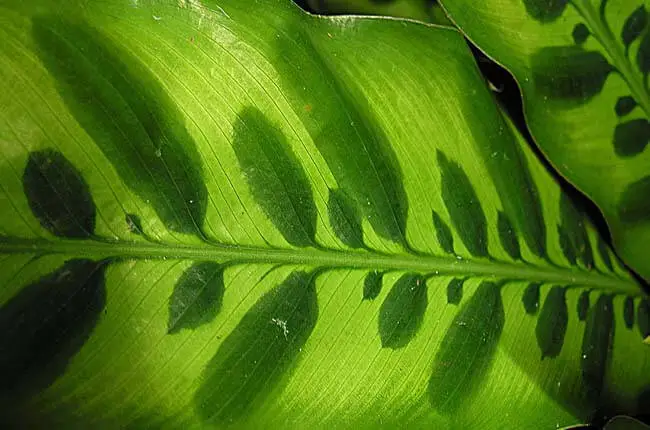
Dick Culbert from Gibsons, B.C., Canada, CC BY 2.0, via Wikimedia Commons
3. Watermelon peperomia
Watermelon peperomias (Peperomia argyreia) are evergreen perennials that can grow up to 8 inches (20 cm) tall and across, with oval leaves held on red stems.
The leaves have silver stripes not because of a lack of chlorophyll, but because of the structure of the leaves with air pockets trapped under the surface of the leaves and above the green layer. It gives off a silvery color when light strikes the leaf surfaces.
This type of variegation is known as blister variegation, which is natural and stable and new leaves will have the same variegated pattern.

(Photo by David J. Stang, CC BY-SA 4.0, via Wikimedia Commons)
Cultivars with stable variegation
Apart from plants with natural variegation encoded in their DNA, different plant species can be crossed artificially in the laboratory by tissue culture to create a cultivar or a chimera (i.e. with more than one set of genotypes) with variegation.
However, not all cultivars have stable variegation.
Whether a cultivar has stable variegation depends on whether cell mutation takes place at the apical meristem, or at the shoot tips where new cells are produced. Mutated cells that cannot synthesize the green pigment, chlorophyll, manifest as white or other colors other than green.
The most stable form of chimeral variegation is called “periclinal” where mutated cells exist at the entire epidermal layer of the shoot tips. Plants with mutated cells at only parts or sectors of the epidermal layer at the shoot tips will result in unstable variegation (i.e. “sectorial variegation”).
Chimeral variegation, however, can only be passed onto its offspring by propagating the shoots with variegation, rather than via seeds.
Cultivars with stable variegation are less common than cultivars with unstable variegation.
4. Variegated Spider Plant
Variegated Spider Plant (Chlorophytum comosum ‘Vaittatum’) is a cultivar of the Spider plant, which is a perennial native to southern Africa. It is a common houseplant grown in hanging baskets with long strap-like leaves and runners bearing smaller plants.
This cultivar has white/yellow margins and a green center. Another cultivar, Chlorophytum comosum ‘Variegatum’, has green margins and a yellow/white center.
The variegation is periclinal chimeral with a combination of normal cells and mutated cells lacking chlorophyll, making them appear white.
The variegation is stable and can be preserved by potting up plantlets taken from the runners.
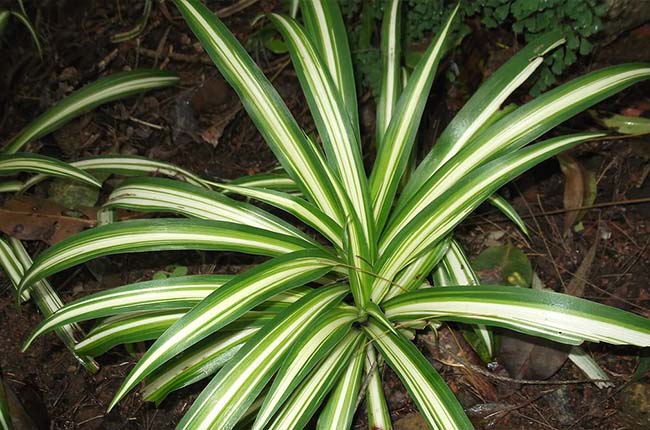
( Yercaud-elango, CC BY-SA 4.0, via Wikimedia Commons )
5. Variegated Holly
Variegated Holly (Ilex aquifolium ‘Argentea Marginata’) is a cultivar of the English Holly which is an evergreen flowering shrub with thick and spiked oval leaves.
The variegation manifests with yellow on the margins of the green leaves.
The variegation is periclinal and is stable, that propagation using stem cuttings will result in the same variegation.

(Photo by David J. Stang, CC BY-SA 4.0, via Wikimedia Commons)
6. Song of India
The Song of India (Dracaena reflexa ‘Variegata’) is a cultivar native to islands on the Indian Ocean. It is a tropical plant with long tapering leaves.
Young plants have deep green leaves with yellow-lime green variegation at the margins. As the plant grows the colors lighten, becoming mid-green with cream margins.
The variegation is chimeral with mutated cells on the leaf margins. The variegation is stable and can be preserved by propagation via stem cuttings.
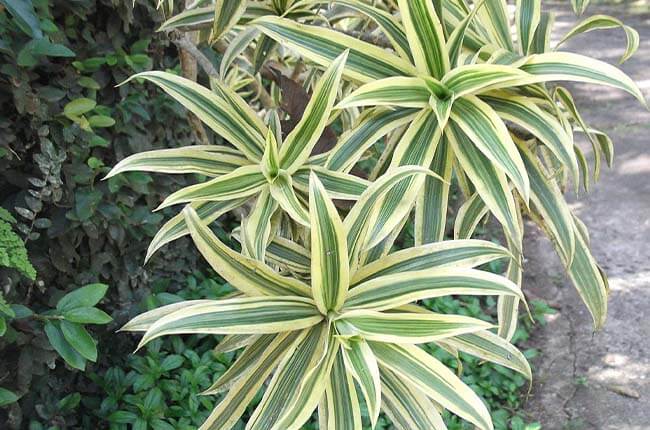
(Yercaud-elango, CC BY-SA 4.0, via Wikimedia Commons)
7. Variegated Winter Daphne
Variegated Winter Daphne (Daphne odora ‘Aureomarginata’) is a cultivar of the Winter Daphne.
It is a compact evergreen and flowering shrub. It has thick glossy green leaves with creamy white margins.
The variegation is periclinal chimeral, which is stable and does not revert under changing growing conditions. This cultivar is also surprisingly hardier than the actual non-variegated species.
Propagation can be made with stem cuttings, with the same variegation in the new plant.

(Photo by David J. Stang, CC BY-SA 4.0, via Wikimedia Commons)
Naming plants with variegation
You can look at the scientific name or botanical name of a plant to get some clues about whether it has stable or unstable variegation.
But the naming system is different for plants with natural (stable) variegation and for cultivars with artificially induced (unstable) variegation.
For plants with both naturally variegated and non-variegated varieties, the variegated variety will have the same scientific name as the non-variegated variety with “var.” (short form for variety) followed by the Latin word“variegata” added at the end. The Latin words are italicized.
Examples:
- Common prickly pear (Opuntia monacantha)
- Variegated prickly pear (Opuntia monacantha var. variegata)
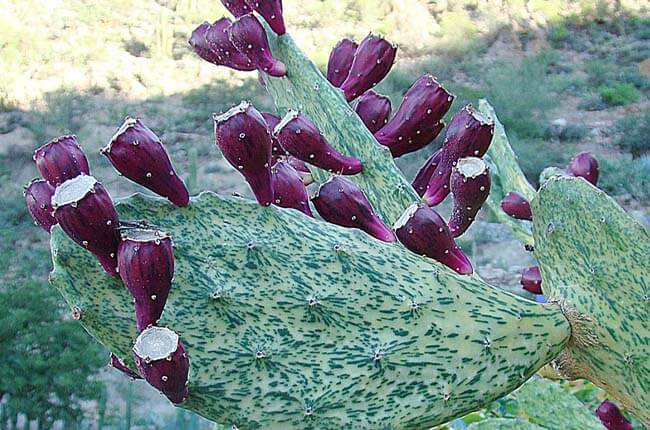
(Dick Culbert from Gibsons, B.C., Canada, CC BY 2.0, via Wikimedia Commons)
And for plants with natural (stable) variegation but without a non-variegated counterpart, they have a unique botanical name without the word “variegata” added at the end.
Examples:
- Snake plant (Dracaena trifasciata)
- Zebra plant (Calathea zebrina)
- Watermelon peperomia (Peperomia argyreia)
However, the naming system is slightly different for plants with unstable variegation or cultivars that are artificially created by plant breeders using different techniques. Their scientific name also has “Variegata” (in capital “V”) at the end but it is written inside single quotation marks. Alternatively, “cv” (abbreviation for cultivar) can be used instead of quotation marks.
Example: The variegated cultivar of Indian cob can be named Euphorbia mammillaris ‘Variegata’ or Euphorbia mammillaris cv. Variegata.
Related:
4 Ways To Induce Variegation In Plants (Explained)
14 Plants With Unstable Variegation (And How To Keep It)
References
Frank, H., & Chitwood, D. H. (2016). Plant chimeras: The good, the bad, and the ‘Bizzaria’.
Lineberger, R. D. & Texas A&M University. Origin, Development and Propagation of Chimeras. Texas A&M University.
New York Botanical Garden. What is the proper way to write a botanical name (Latin name)? – Gardening FAQ. NYBG.
Texas A&M University. Plant Identification and Taxonomy. TAMU.
University of Florida (2020). Chimeras.
Khoo, H. E., Azlan, A., Tang, S. T., & Lim, S. M. (2017). Anthocyanidins and anthocyanins: colored pigments as food, pharmaceutical ingredients, and the potential health benefits. Food & Nutrition Research, 61(1), 1361779.
- Keiki Paste vs Rooting Hormone:What’s the difference? - February 4, 2024
- Top 10 Orchid Fertilizers: A Comprehensive Review (2024) - February 2, 2024
- Top 8 Soil Inoculants For Stronger Plants (2024) - February 1, 2024

